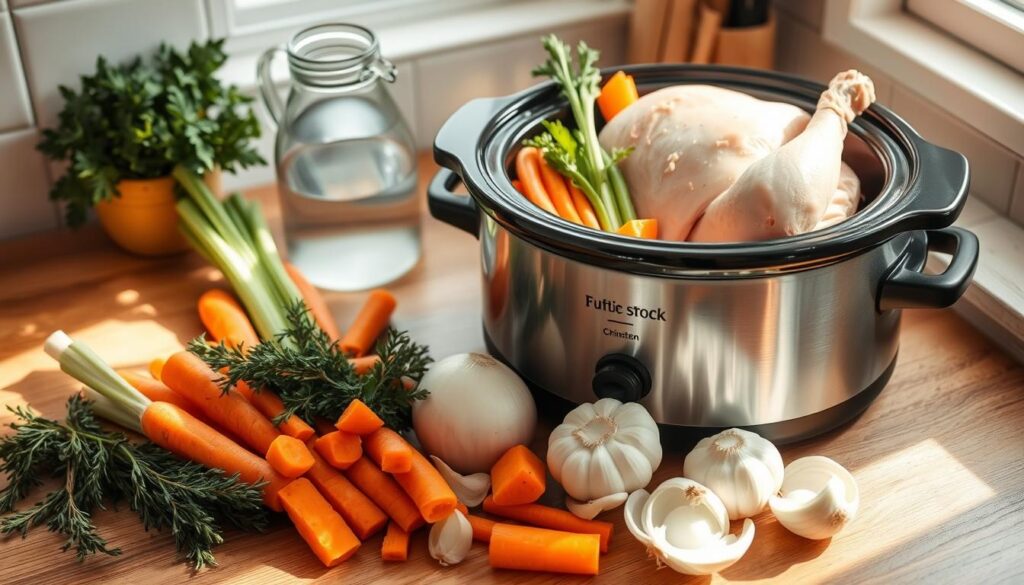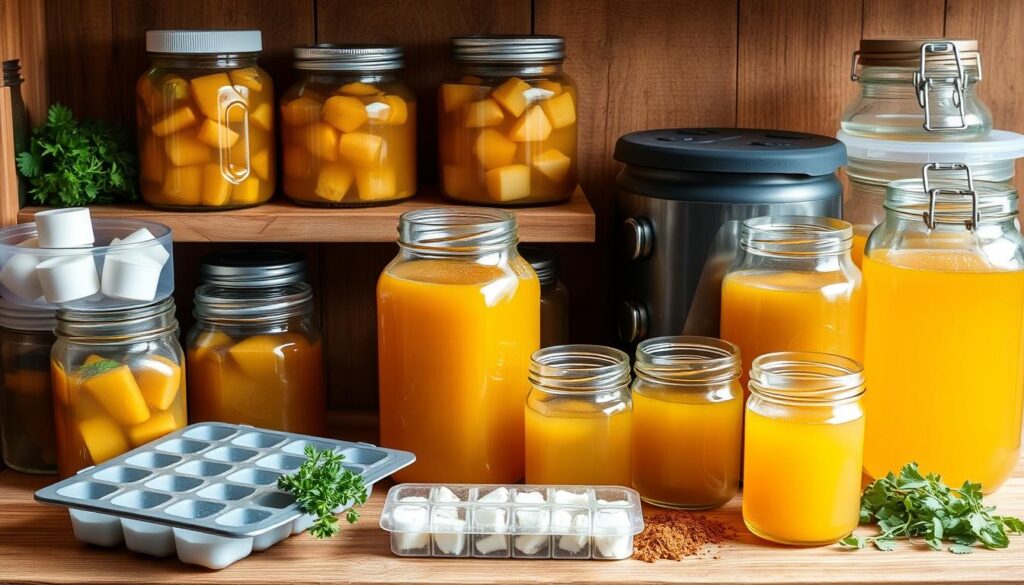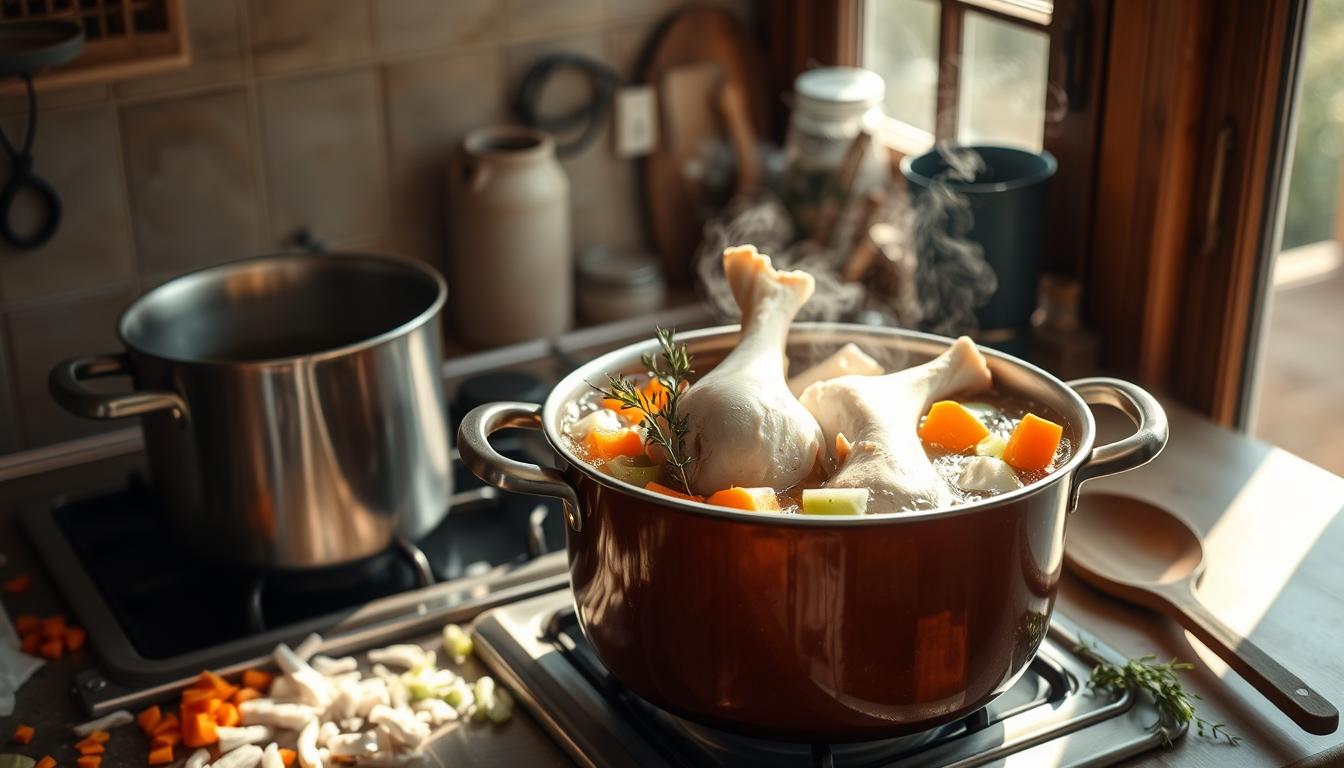Easy Steps to Make Homemade Chicken Stock from Scratch
Make Homemade Chicken Stock from Scratch
Every time I walk into my kitchen with leftover chicken bones, I’m reminded of my grandmother’s wisdom: nothing goes to waste. Making homemade chicken stock isn’t just a recipe—it’s a culinary tradition. It transforms simple ingredients into liquid gold.
Learning to make chicken stock from scratch is a game-changing skill for home cooks. With just a few basic ingredients, you can create a rich, flavorful base. This base elevates soups, sauces, and countless other dishes. Making homemade stock is easier than you might think, whether you’re using a stovetop, Instant Pot, or slow cooker.
The beauty of homemade stock lies in its simplicity and versatility. By simmering chicken bones with aromatic vegetables and herbs, you’ll extract deep, complex flavors. These flavors are unmatched by store-bought versions. The process not only reduces food waste but also provides a nutrient-dense ingredient for your kitchen.
Table of Contents
Understanding the Difference Between Homemade Chicken Stock and Broth
Chicken broth and bone broth might seem the same at first glance. But they have key differences that make them unique. Knowing these can improve your cooking and help pick the best liquid for your dishes.
Chicken stock is made from bones, which makes it rich and gelatinous. On the other hand, chicken broth is made from meat, giving it a lighter taste.
Detailed Characteristics
- Chicken Stock:
- Made primarily from bones
- Thicker consistency due to collagen
- Higher protein content
- Less seasoned
- Chicken Broth:
- Made from meat
- Lighter texture
- More seasoned
- Immediate consumption focus
Culinary experts call both “liquid gold” because they’re so versatile. Making chicken stock takes about 2.5 hours, which helps extract more flavor.
“The primary distinction between chicken stock and chicken broth is the presence of gelatin” – Culinary Experts
| Characteristic | Chicken Stock | Chicken Broth |
|---|---|---|
| Primary Ingredient | Bones | Meat |
| Consistency | Thick, gelatinous | Light, fluid |
| Typical Use | Sauces, soups base | Direct consumption, lighter dishes |
When deciding between chicken broth and bone broth, think about your recipe. Stock is great for hearty dishes, while broth is better for lighter ones.
Essential Ingredients for Rich Homemade Chicken Stock
Making a tasty chicken stock begins with picking the right ingredients. Your homemade stock can make many dishes better with its rich flavor. Knowing which chicken parts and aromatics to use will change your cooking for the better.
Best Chicken Parts to Use
Not all chicken parts are the same when making stock. The best ones are:
- Chicken carcass (4-6 pounds is ideal)
- Chicken feet for extra gelatin and richness
- Chicken wings for added flavor intensity
- Backs and necks
“The secret to a great stock is using a variety of chicken parts that bring different qualities to the pot.”
Required Aromatics and Vegetables for Make Homemade Chicken Stock
Aromatics are the base of your stock’s flavor. Your mix should include:
| Ingredient | Quantity | Purpose |
|---|---|---|
| Onions | 1 (quartered) | Depth of flavor |
| Carrots | 3-4 large | Sweetness |
| Celery | 4 stalks | Aromatic base |
| Garlic | 1 head | Robust flavor |
Herbs and Seasonings Selection
Add depth to your stock with the right herbs and seasonings:
- Fresh thyme sprigs
- Parsley stems
- Bay leaves
- Black peppercorns
- Kosher salt
Pro tip: Leave herbs and vegetables unpeeled to maximize flavor extraction. Aim to make a stock that’s rich and complex. It will be the base for many delicious meals.
Equipment Needed to Make Chicken Stock
To make the perfect chicken stock, you need the right kitchen tools. The tools you choose can greatly affect the taste and quality of your homemade stock.
- Large Stockpot: A minimum 12-quart capacity pot allows ample space for ingredients
- Fine-mesh strainer for removing solids
- Skimmer or slotted spoon for removing foam during simmering stock
- Storage containers or freezer-safe bags
- Measuring cups
When picking your stockpot, look for these important features:
| Pot Material | Pros | Recommended Size |
|---|---|---|
| Stainless Steel | Durable, conducts heat evenly | 12-16 quarts |
| Aluminum | Lightweight, affordable | 8-12 quarts |
| Enameled Cast Iron | Excellent heat retention | 10-14 quarts |
“The right pot transforms ordinary ingredients into liquid gold.” – Professional Chef
Other cooking methods like slow cookers or pressure cookers can also make great chicken stock. Each method has its own benefits for getting the most flavor from your chicken bones and veggies.
How to Make Chicken Stock on the Stovetop
Making homemade bone broth on the stovetop is a great way to turn kitchen scraps into a delicious liquid. This method makes chicken stock much tastier than store-bought versions.
Preparing Your Ingredients
To make chicken stock, you’ll need a few important ingredients:
- 3-4 pounds of chicken bones or whole chicken
- 1-2 medium yellow onions, quartered
- 3-4 medium carrots
- 3-4 celery stalks with leaves
- Handful of parsley stems
- 3-4 bay leaves
- 3-4 sprigs of fresh thyme
- 2 tablespoons whole black peppercorns
Simmering and Skimming Techniques
The secret to clear, rich homemade bone broth is careful simmering. Start by boiling your ingredients gently, then skim off any foam. This step removes impurities for a clean taste.
“A slow, patient simmer is the secret to extracting maximum flavor from your chicken stock.”
Straining and Cooling Process
| Simmering Step | Details |
|---|---|
| Initial Cooking Time | Minimum 4 hours, optimal 5 hours |
| Water Quantity | 16 cups of water |
| Refrigeration | Up to 5 days |
| Freezing | 6-12 months |
After your stock simmers perfectly, strain it through a fine-mesh strainer. Let it cool completely before storing. A pro tip: refrigerate the stock overnight. Then, you can easily remove solidified fat from the top before using or freezing.
Your homemade chicken stock is now ready to enhance soups, sauces, and many other recipes with its deep, rich flavor.
Instant Pot Chicken Stock Method
Making chicken broth from bones is now super easy with an Instant Pot. This modern cooking method makes your kitchen work faster. You get rich, flavorful stock in much less time than before.
The Instant Pot changes how we make chicken broth. It cuts down on prep time but keeps the flavor strong. You’ll get a stock full of nutrients, better than stovetop methods.
Key Preparation Steps
- Gather 1 kg of chicken bones
- Prepare vegetables: 1 medium onion, 1 carrot, 1 corn
- Optional additions: 4 garlic cloves, cilantro roots
- Add 1-2 tablespoons apple cider vinegar
Instant Pot Stock Method
- Fill Instant Pot approximately one-third full with chicken bones
- Add chopped vegetables
- Pour water to maximum fill line (2.5 liters)
- Seal lid and set to high pressure
There are two main steps: high-pressure cooking and natural release. Cook at high pressure for 45-60 minutes. Then, let it rest for 10 minutes before opening.
| Cooking Parameter | Recommended Setting |
|---|---|
| Pressure Level | High |
| Cooking Time | 45-60 minutes |
| Pressure Release | Natural (10 minutes) |
| Total Process Time | Approximately 1 hour 15 minutes |
Pro tip: Roasted chicken bones provide a deeper, more concentrated flavor compared to raw bones.
“The Instant Pot transforms bone broth making from a day-long process to a quick, efficient cooking method.” – Culinary Experts
After cooking, strain the stock and store it in airtight containers. Keep it in the fridge for up to 5 days or freeze for 3 months. This way, you always have homemade, nutritious chicken stock ready.
Slow Cooker Chicken Stock Instructions
Making homemade stock in a slow cooker is easy and convenient. It turns leftover chicken bones into a rich, nutritious liquid. This method lets you make delicious chicken stock with little effort and lots of flavor.

Slow cookers are perfect for making chicken stock. They keep a steady low heat that brings out flavors and nutrients. The long cooking time breaks down bones, releasing all their goodness.
Time and Temperature Guidelines
When making chicken stock in a slow cooker, follow these guidelines:
- Set slow cooker to LOW temperature
- Cook for 10-12 hours (overnight works best)
- Aim for maximum nutrient extraction
Slow Cooker Success Tips
To make the best homemade stock, use these professional tips:
- Fill slow cooker no more than 3/4 full
- Use filtered water for clearer stock
- Add 2 tablespoons of apple cider vinegar to help extract minerals
“The secret to great stock is patience and low, steady heat.” – Professional Chef
| Ingredient | Quantity |
|---|---|
| Chicken Bones | 1-2 chicken carcasses |
| Water | 10-12 cups |
| Vegetables | 2 carrots, 2 celery stalks, 1 onion |
| Cooking Time | 10-12 hours on LOW |
By following these steps, you’ll make a nutrient-rich homemade stock. It’s up to 93% cheaper than store-bought. Your slow cooker chicken stock will give you about 4 quarts of delicious liquid gold for your cooking.
How to Achieve Clear, Rich-Flavored Stock
Making a crystal-clear chicken broth needs careful steps and attention. You aim for a broth that’s tasty and looks great, with a clear finish.
Several techniques are key to a clear stock:
- Start with cold water when beginning your stock
- Skim foam consistently during cooking
- Maintain a gentle, low simmer
- Avoid stirring the stock
To clear your broth, remove impurities. Gentle heat is crucial – a rolling boil can make it cloudy.
“A clear stock is a sign of patience and precision in the kitchen” – Professional Chef Technique
Skimming is important. Use a fine mesh skimmer to remove foam in the first hour. This step gets rid of proteins that cloud your broth.
Choosing the right ingredients also matters. Pick fresh veggies, skip green leek parts, and use clean chicken bones for the best clarity.
By following these steps, you’ll make a broth that’s not only tasty but also clear. It’s a true kitchen win.
Tips for Maximum Flavor Extraction
Making a flavorful homemade bone broth is more than just throwing ingredients in a pot. Professional chefs have secrets to get the most flavor from simmering stock. Now, you can learn these tricks too.
The secret to a great homemade stock is understanding the art of flavor development. Let’s explore the key methods to make your chicken stock stand out.
Optimal Cooking Times for Rich Flavor
Time is crucial when making homemade bone broth. Here are some important tips:
- Simmer stock on low heat for at least 2 hours
- Cooking for up to 24 hours can make the flavor even deeper
- Professional kitchens often make fresh stock daily for the best taste
“The longer you simmer, the more flavor compounds you’ll extract.” – Culinary Wisdom
Mastering Temperature Control
Temperature is key for a clear, rich stock. Start with cold water to get the most flavor. A gentle, steady simmer is the secret to avoiding cloudiness and getting the best taste.
| Cooking Method | Recommended Time | Flavor Intensity |
|---|---|---|
| Stovetop | 3-12 hours | High |
| Slow Cooker | 8-12 hours | Medium-High |
| Instant Pot | 1.5 hours | Moderate |
Pro tip: Smash chicken bones before cooking to release more gelatin. This makes your homemade bone broth even richer. Your broth will thank you!
Proper Storage and Freezing Methods
Keeping your homemade stock fresh is key. It’s important to store it right to keep the flavor and ensure safety. You can store it in the fridge or freezer, each with its own benefits.

For short-term storage, the fridge is best. Your stock stays fresh for 3-4 days in airtight containers. Make sure it cools down completely before putting it in the fridge to avoid bacteria.
Freezing Guidelines
Freezing is the top choice for long-term storage. Here are some tips:
- Freeze stock in 4-6 cup portions for easy recipe use
- Use freezer-safe glass containers or heavy-duty freezer bags
- Leave 1-inch space at the top for liquid expansion
- Label containers with date and quantity
Freezing Duration and Quality
| Storage Method | Duration | Quality Preservation |
|---|---|---|
| Refrigerator | 3-4 days | Excellent |
| Freezer | 3-6 months | Very Good |
Thawing Techniques
Ready to use your frozen bone broth? Here’s how to thaw it safely:
- Refrigerator thawing (recommended): Move stock to refrigerator overnight
- Cold water method: Submerge sealed container in cold water for approximately 4 hours
“Proper storage transforms your homemade stock from a simple ingredient to a culinary treasure.” – Culinary Expert
Don’t microwave frozen stock. It can ruin the flavor and heat unevenly. For the best taste, add fresh herbs when you reheat it.
Using Homemade Stock in Various Recipes
Your homemade chicken stock is a culinary powerhouse. It turns ordinary dishes into extraordinary meals. Its rich flavor and nutritional benefits make it a versatile ingredient.
Soup Base Mastery
Homemade stock is perfect for many soup recipes. Using your own chicken broth adds a depth of flavor that store-bought can’t match.
- Create hearty vegetable soups
- Develop rich minestrone recipes
- Enhance classic chicken noodle soup
- Prepare creamy pureed soups
Sauce and Gravy Enhancement
Your homemade stock is a secret weapon for sauces and gravies. It adds an unparalleled richness that will impress any home cook.
| Recipe Type | Stock Usage | Flavor Impact |
|---|---|---|
| Pan Sauces | 1/2 cup | Intense, complex |
| Gravy | 1-2 cups | Deep, savory |
| Risotto | 4-5 cups | Creamy, rich |
Versatile Cooking Liquid
Beyond soups and sauces, your chicken broth can replace water in many recipes. Use it to cook grains, steam vegetables, or add moisture to casseroles for a flavor boost.
“A great stock is the foundation of great cooking” – Unknown Chef
Pro tip: Freeze your homemade stock in 2-cup portions for easy recipe preparation. With proper storage, your stock will stay good for up to 3 months in the freezer.
Nutritional Benefits of Homemade Stock
Homemade bone broth is more than just a tasty kitchen staple. It’s a nutritional powerhouse that supports your health. When you make it at home, you get a mineral-rich liquid that’s better than store-bought options.
The magic of bone broth is in its unique nutrients. It extracts valuable nutrients from chicken bones and connective tissues during slow simmering. These include:
- Collagen – supports joint and skin health
- Amino acids like glycine and proline
- Minerals such as calcium and magnesium
- Essential proteins that aid digestion
Clinical research shows the benefits of bone broth. For example, studies suggest it can:
- Improve skin hydration and elasticity
- Support gut health and intestinal function
- Potentially reduce inflammation
- Enhance sleep quality
“Your body absorbs nutrients from homemade bone broth much more effectively than processed supplements.” – Nutrition Expert
What makes homemade bone broth special is your control over ingredients and cooking time. Simmering bones for 12-24 hours maximizes nutrient extraction. A typical batch needs 2-4 pounds of bones per gallon of water, making it a nutrient-dense liquid.
While bone broth isn’t a miracle cure, it’s a great addition to a balanced diet. Drinking 300ml can boost amino acid levels, supporting collagen formation and overall nutrition.
Conclusion
Learning to make chicken stock at home changes your cooking. It makes your dishes richer and more flavorful. You’ll find it’s easier than you think, needing just basic ingredients and patience.
Creating homemade stock helps you use up kitchen waste. It lets you make a nutritious base for soups and sauces. You’ve learned how to make it on the stovetop, in the Instant Pot, or slow cooker.
Making your own stock has many benefits. You control what goes into it and save money. You can store it in the fridge or freezer, making it easy to use in future meals.
With these skills, you turn kitchen scraps into a tasty base for your dishes. Making chicken stock will make your cooking more creative and delicious.







